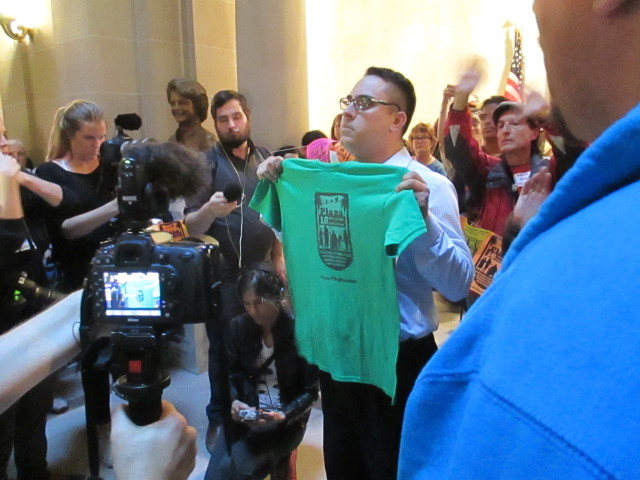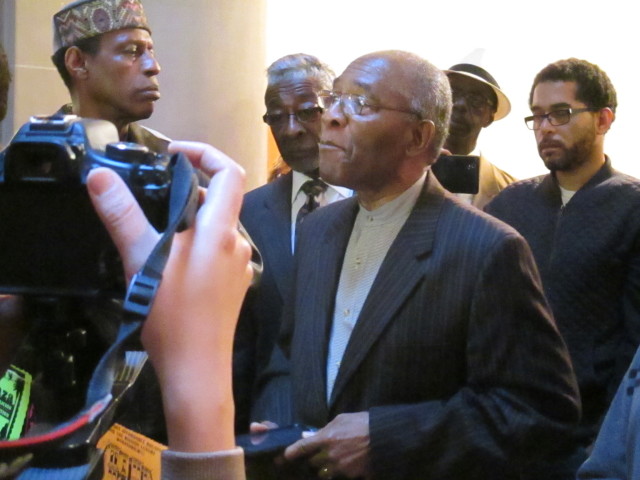Hundreds and hundreds of Mission residents and community activists demonstrate the massive anger over displacement — and some folks at City Hall didn’t listen. This isn’t over

By Tim Redmond
JUNE 2, 2015 – The San Francisco supervisors rejected the pleas of hundreds of Mission District residents and community and faith leaders tonight and refused to put even a 45-day halt on luxury housing development in the Mission.
The vote was an encouraging 7-4. Although the measure needed nine votes, Sups. John Avalos, David Campos, Jane Kim, Eric Mar, London Breed, Malia Cohen, and Norman Yee voted yes.
Sups. Scott Wiener, Julie Christensen, Katy Tang, and Mark Farrell voted no.
It came after a long hearing that was one of the most powerful statements I’ve ever seen of the pain, suffering, and loss that the tech boom, encouraged and driven by Mayor Ed Lee, has caused. It was a profound statement of the failure of the city’s development and housing policy.
And it’s stunning that four supervisors rejected the cries for help of the Mission community.
Sup. David Campos proposed the moratorium as a way to get a grip on a the wave of displacement in a part of the city that has become ground zero for tech-driven gentrification.
Campos introduced the measure by showing a map of 90 luxury housing projects that have been built or are in the pipeline for the Mission. There are, he said, only 13 sites left for affordable housing.
There is, he said, a huge deficit between affordable and luxury housing, and “we need to address the imbalance.”
The measure was co-sponsored by Sups. Jane Kim, Eric Mar, John Avalos, and Norman Yee. They all spoke in favor. Mar said that the city “is facing the same ethnic cleansing [in the Mission] as the Fillmore and Manilatown. … If you rely on the market forces alone, more people will be forced out.”
Kim argued that the measure “isn’t about a moratorium, it’s about a plan.” Community groups in the Mission are working on a proposal to rezone the area to promote affordable housing. In the Soma area, she said, the city’s getting closer to the 33 percent affordable housing rules that were put in place with Prop. K. In the Mission, it’s way, way below that.
Yee said that he had lived in the city longer than anyone else on the board, and had seen plenty of changes. “But this is the most radical change I have ever seen.”

Sups. Scott Wiener and Mark Farrell had both already announced their opposition to the plan. Wiener said what he has said repeatedly: Yes, there is a housing crisis. The city hasn’t built enough housing in the past 30 years, And as the population grows, we will need even more housing.
“There’s a lot the city can do, with in-law units, group housing, student housing,” he said. “The moratorium isn’t the way to get there.”
Wiener has consistently said that he thinks the private market will help with the housing crisis. He argues that the fees pays by the developers of luxury housing are a key source of funding affordable housing.
I thought that some of the undecided supes would listen to the testimony from the public before coming to a conclusion. I know, silly – that’s how it’s supposed to work, but too often, a call from a lobbyist or the mayor trumps everything that more than 100 people, many from the Mission, most overwhelmingly in favor of the moratorium, had to say.
Sup. Julie Christensen announced, before public testimony started, that her office had done “a lot of research” into the issue. She said she had planned earlier in the day to vote in favor of the moratorium because “these people want it.” But somehow, she changed her mind, and said that the Eastern Neighborhoods Plan, supported by the board in 2008, set the rules for development in the area.
“What I do not see here is a plan to solve the problem,” she said. Addressing the overwhelming majority of Mission residents and activists, she said, “I don’t want any of us in the room to think that I don’t care about you. … We understand that it’s an issue and we are listening to you. But I’m looking for a plan.”
Kim responded: “How are we going to get a plan if we don’t do this?”
She added that the moratorium is not just about protecting housing, it’s about protecting industrial jobs.
Hundreds go to the mayor’s office
The hearing began just as several hundred demonstrators, including some religious leaders, formed a circle in front of the Mayor’s Office to call on Lee to support the moratorium. Among the speakers: Rev. Amos Brown, a former supervisor and pastor of Third Baptist Church who is also president of the local branch of the NAACP.
Brown, who as a supe was in no way a foe of development, spoke of the displacement of African Americans from the Western Addition, and said that “injustice anywhere is injustice everywhere.”
The activists asked the mayor to open the door, and chanted as sheriff’s deputies blocked the entrance. Nobody from the Mayor’s Office came out. The faith leaders were unable to deliver a “good faith” T-shirt to the mayor.
The sound of their chants echoed in the board chamber, and at times drowned out the testimony.
For more than seven hours, a long line of speakers told of the crisis in the mission, of the evictions they’re facing, of the destruction of community and families, of mental health issues, of the need to take a break so that the Mission can plan for itself.
Brian Basinger, who founded the AIDS Housing Alliance, pointed out that “I begged this board to come up with a housing plan when you approved the Twitter tax break. … This body owns this. You own it and you have to fix it.”
There were people speaking against the moratorium, but they were a very small minority. The overwhelming majority, including many Latino residents of the Mission, argued for the measure.
I met some of the opponents standing in the line waiting to talk. Sonja Trauss, who founded SFBARF, didn’t argue with the premise that private developers won’t build middle-class housing, that all of the private construction in the Mission will be for rich people.
That’s fine with her: “Build housing for rich people,” she said. “New stuff is always for rich people. If you build housing for them, they won’t want to take someone else’s apartment.”
She told me that she doesn’t think luxury housing increases property values in the surrounding area.
She also said that the Mission should be rezoned to let developers build “anything that pencils out – 16, 24, 30-story buildings.”
One other speaker said that he “took issue with the idea that the private market can’t be part of the solution.” I didn’t get his name, but he said upzoning the Mission would “set a precedent for upzoning other neighborhoods.”
That’s one perspective.
Of course, we have seen that much of the high-end housing isn’t occupied by rich people – or anyone else. So it’s a stretch to say that turning the Mission into midtown Manhattan will actually prevent evictions and preserve the existing community.
It’s clear what the community wants
I have to say I saw a certain amount of patronizing here: There is overwhelming support for this plan among Latinos, low-income people, and longtime Mission residents. It’s not a radical concept, just a short-term halt in development that’s tearing a community apart.
There are at least two competing perspectives on the economics of a moratorium, but there aren’t two perspectives on what the community wants.
One woman who spoke discussed how “the city is being taken over by a white elite. Not everyone in the city can make $100,000 or more. We want to have economic diversity. There are enough luxury units, we don’t need more.
Kimberly Alvarenga, a longtime community activist, said that her mother and father, both immigrants, met in 1963 at 24th and Florida, and when she was growing up “it was a working class neighborhood. Working class people can’t stay here anymore. If you don’t do something today, you will have failed them.”
It was painful to listen to some of the testimony. A woman who works as a domestic violence advocate talked of how abused women can’t leave their intolerable situations because there is nowhere else affordable to go. Young people talked of how they can’t afford to live here and go to school. People who were born in the city spoke of being forced to leave. The idea that this situation is tolerable — that it can continue without something dramatic happening — is beyond comprehension.
There’s been only limited attention in the news media to the role this measure would have in protecting industrial buildings and jobs. The Campos measure would, among other things, prevent the conversion of what’s called production, distribution, and repair facilities to office or restaurant space.
All over the Mission, PDR – which offers space for artists, space for jobs that don’t require a college degree, and space for neighborhood services – is being converted to other uses. In many cases, it’s happening illegally.
There’s also the much larger question: Should the Mission, and San Francisco, be forced to accept the consequences of every type of commercial growth that venture capitalists want to foist on the city? There was a time, in the 1980s, when commercial office development was out of control, and urban environmentalists came up with the concept of “reasonable growth:” It’s okay for the city to get bigger, but not without some thought. Not as fast as the developers and the investors want. Not faster than the city’s transportation and housing infrastructure can handle.
So now, after all of this, we know where some of the supervisors in the center stand on this. We have also seen the beginning of a movement, of anger and organizing on a scale I haven’t seen in a long time. I don’t think in 30 years I’ve ever seen this many people from one neighborhood testify at City Hall on a development issue. It isn’t going away. If anything, it is going to get more intense.
“In my seven years on the board, I have never seen anything like what happened today. To my colleagues, I have to ask, what would you do if this many of your constituents came out today?
“I know this is not the end because we have started something a movement.”
It was amazing to hear hundreds of people stand up and say: We can’t tolerate what’s happening in the city any more. We want something to change – right now, today.
If nothing else, I hope the supervisors, and the mayor, and the rest of the city, got that message.




